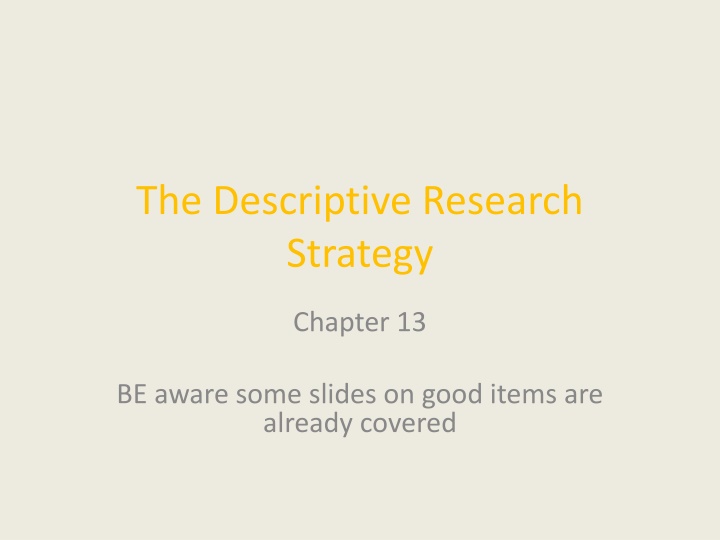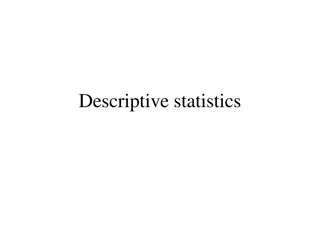
Descriptive Research Methods in Social Sciences
"Learn about the descriptive research strategy in social sciences, focusing on measuring variables naturally. Explore examples, research designs, sampling techniques, and measurement processes for effective data collection and analysis."
Download Presentation

Please find below an Image/Link to download the presentation.
The content on the website is provided AS IS for your information and personal use only. It may not be sold, licensed, or shared on other websites without obtaining consent from the author. If you encounter any issues during the download, it is possible that the publisher has removed the file from their server.
You are allowed to download the files provided on this website for personal or commercial use, subject to the condition that they are used lawfully. All files are the property of their respective owners.
The content on the website is provided AS IS for your information and personal use only. It may not be sold, licensed, or shared on other websites without obtaining consent from the author.
E N D
Presentation Transcript
The Descriptive Research Strategy Chapter 13 BE aware some slides on good items are already covered
Descriptive research Typically involves measuring a variable or set of variables as they exist naturally. The descriptive strategy is not concerned with relationships between variables but rather with the description of individual variables.
Examples The suicide rate for college students is about 7.5 a year per 100,000 students. Survey results show that 61% of the adults in the United States currently drink alcohol. Facebook has replaced Google as the number one website in the United States.
Three descriptive research designs the observational research design, the survey research design, and the case study research design.
Sampling Observations When an observer is confronted with a complex situation take a sample of the potential observations rather than attempt to watch and record everything. 1. Time sampling (1stweek, 5thweek, 20thweek) 2. Event sampling (communication, collaboration, stay on task) 3. Individual sampling (observe individuals one by one)
Measurement process 1. Establishing behavioral categories A list of behaviors that is defined as aggressive behavior Yelling Sulking Pushing Defiance Name calling
Measurement process 2. Obtain a numerical score for each behavioral category using the frequency method (how many students or how many times) the duration method (how long) the interval method (how often in 5 minutes)
Measurement process 3. Using multiple observers for at least part of the measurement process to obtain a measure of inter-rater reliability.
Problems with observation 1. The behaviors might be disrupted or influenced by the presence of an observer. 2. Subjective judgment, raises the question of reliability
Solutions Concealing the observer Habituation Develop a list of well-defined categories of behavior; Use well- trained observers Use multiple observers
Types of observation In naturalistic observation, or nonparticipant observation, a researcher observes behavior in a natural setting as unobtrusively as possible. (one-way mirrors) In participant observation, the researcher engages in the same activities as the people being observed in order to observe and record their behavior. (high school confidential) Contrived observation, or structured observation, Observation of behavior in settings arranged specifically to facilitate the occurrence of specific behaviors. (Bully)
Content Analysis Content analysis involves using the techniques of behavioral observation to measure the occurrence of specific events in literature movies television programs other media
The survey research design A research study that uses a survey to obtain a description of a particular group of individuals is called a survey research design.
Types of Questions Open- Ended Questions In your view, what are the most important factors in choosing a college or university? Restricted Questions If the election were held today, which of the following candidates would receive your vote? a. Mr. Jones b. Ms. Smith c. Mr. Johnson
Likert scale This type of rating-scale question is often called a Likert scale Researchers commonly use from 5 to 10 numerical values.
Criticism of rating- scale One criticism of rating- scale questions is that participants tend to use the same response to answer all ( or most) of the questions. This tendency is called a response set. It is recommended that the items include a mixture of positive and negative
Semantic Differential presents pairs of bipolar adjectives ( such as happy sad, boring exciting), and asks each participant to identify the location between the two adjectives that best describes a particular individual.
Survey General Guidelines Don t forget demographic questions Sensitive questions should be placed in the middle of the survey. Questions dealing with the same general topic should be grouped together. The format for each page should be relatively simple and uncluttered. Finally, vocabulary and language style should be easy.
Sampling Select survey participants to whom the questions are relevant. The sample of survey participants must not be too restricted.
Administering a Survey Mail survey Telephone survey Email survey Online forms In-person surveys or interviews
The Case Study Design Why in this chapter?
The Case Study Design The case study design involves the in- depth study and detailed description of a single individual ( or a very small group). A case study may involve an intervention or treatment administered by the researcher. When a case study does not include any treatment or intervention, it often is called a case history.
Applications of the Case Study Design Most commonly used in clinical psychology Often used to provide researchers with information concerning rare or unusual phenomena such as multiple personality To use the detailed description of a single individual to demonstrate an exception to the rule To show that the treatment does not always work.






















